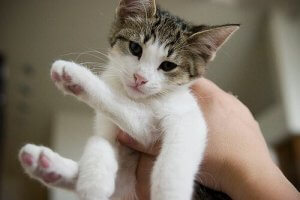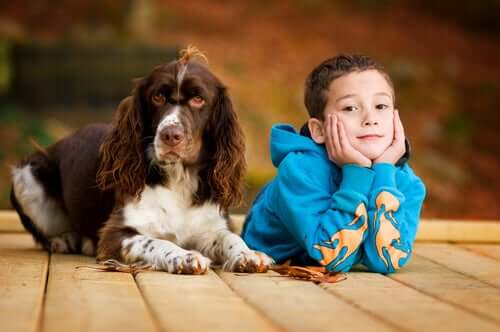What's the Ideal Pet for a Child?


Written and verified by the lawyer Francisco María García
Having a pet is beneficial in many ways, especially for young children. This is because it helps them develop their personality and build strong bonds. However, when it comes to deciding which pet is best for a child, a series of questions may come to mind. This is why we decided to share some keys to help you decide what the ideal pet for a child is.
Take the plunge: bring an ideal pet for a child home
Whether because the adults want a pet or because the children ask for one, it’s common for people to face the dilemma of bringing a pet home or not. And, above all, choosing the ideal pet for a child.
You should always remember that having a pet represents responsibility, time, money, and love.
So, before taking the plunge, you should decide with your entire family whether to bring a pet home or not. This is because it entails incorporating another living being into the family that will require special care for many years.

Choosing the ideal pet for a child
A dog
Generally, the first option that comes to people’s minds is a dog.
This animal is ideal for active, affectionate children that demand interaction. A child will surely build strong ties with the dog if they how to interact with it.
The advantage of this pet is that it helps develop the child’s empathy, sociability, and self-esteem, while allowing them to maintain a considerable level of physical activity.
The child can take over some of the responsibilities once they reach a certain age. However, you should know that the adults are the ones left with most of the work. Therefore, you need to have enough time, space, and budget.
The best dog breeds for children are Labradors and Golden Retrievers. Big dogs are better for small children.
A cat
This is a good choice for you if you want a pet to interact with that’s both loving but more independent. It’s the ideal pet for a loving and mischievous child that enjoys their personal space.
The advantage of this animal is that it has the habit of grooming itself and doesn’t require as much care as a dog.
However, you must be aware of the possible occurrence of allergies if your child is older. And you always have to handle it with care.
A parakeet
This is the third most sought after pet after dogs and cats. Parakeets don’t require much care or budget. And, with some time, it will integrate into family life and even with family members.
A parakeet is ideal for observant, curious, and calm children. With adult supervision, the child can undertake some of their care and enjoy the companionship of a great pet.
A guinea pig
This is an excellent choice for homes with young children; even better if it’s their first experience with animals. Guinea pigs are characterized by being active and curious. Once they gain trust, they’re capable of interacting.
It doesn’t require much space because it spends most of its time in its cage and requires simple care.
Something to keep in mind is their hygiene and food, as guinea pigs are prone to becoming overweight.
A rabbit
A rabbit is an ideal pet for somewhat older children, as long as they handle it with care, as it’s a very delicate animal. Rabbits are very affectionate after they gain trust, which can take some time.
The advantage is that rabbits don’t need much space, although they do enjoy running free at certain times of the day.

Rabbits are somewhat distrustful at the beginning, which is why the child must adapt to it.
Tips to choose the ideal pet for a child
Here are some things you should keep in mind:
- The child’s age. If your child is very small and this is going to be their first pet, it’s possibly convenient to start with a parakeet. Then, you should teach them everything that taking care of an animal entails.
- Psychomotor development. Until your child develops coordination, it’s best not to bring home small and delicate animals, as they’ll hurt them unintentionally when they want to interact.
- Dogs are always great company. Remember the child’s age and temperament, and decide based on this. Learning about the characteristics of different breeds is a good idea.
Main picture source: Lindsey Price
Having a pet is beneficial in many ways, especially for young children. This is because it helps them develop their personality and build strong bonds. However, when it comes to deciding which pet is best for a child, a series of questions may come to mind. This is why we decided to share some keys to help you decide what the ideal pet for a child is.
Take the plunge: bring an ideal pet for a child home
Whether because the adults want a pet or because the children ask for one, it’s common for people to face the dilemma of bringing a pet home or not. And, above all, choosing the ideal pet for a child.
You should always remember that having a pet represents responsibility, time, money, and love.
So, before taking the plunge, you should decide with your entire family whether to bring a pet home or not. This is because it entails incorporating another living being into the family that will require special care for many years.

Choosing the ideal pet for a child
A dog
Generally, the first option that comes to people’s minds is a dog.
This animal is ideal for active, affectionate children that demand interaction. A child will surely build strong ties with the dog if they how to interact with it.
The advantage of this pet is that it helps develop the child’s empathy, sociability, and self-esteem, while allowing them to maintain a considerable level of physical activity.
The child can take over some of the responsibilities once they reach a certain age. However, you should know that the adults are the ones left with most of the work. Therefore, you need to have enough time, space, and budget.
The best dog breeds for children are Labradors and Golden Retrievers. Big dogs are better for small children.
A cat
This is a good choice for you if you want a pet to interact with that’s both loving but more independent. It’s the ideal pet for a loving and mischievous child that enjoys their personal space.
The advantage of this animal is that it has the habit of grooming itself and doesn’t require as much care as a dog.
However, you must be aware of the possible occurrence of allergies if your child is older. And you always have to handle it with care.
A parakeet
This is the third most sought after pet after dogs and cats. Parakeets don’t require much care or budget. And, with some time, it will integrate into family life and even with family members.
A parakeet is ideal for observant, curious, and calm children. With adult supervision, the child can undertake some of their care and enjoy the companionship of a great pet.
A guinea pig
This is an excellent choice for homes with young children; even better if it’s their first experience with animals. Guinea pigs are characterized by being active and curious. Once they gain trust, they’re capable of interacting.
It doesn’t require much space because it spends most of its time in its cage and requires simple care.
Something to keep in mind is their hygiene and food, as guinea pigs are prone to becoming overweight.
A rabbit
A rabbit is an ideal pet for somewhat older children, as long as they handle it with care, as it’s a very delicate animal. Rabbits are very affectionate after they gain trust, which can take some time.
The advantage is that rabbits don’t need much space, although they do enjoy running free at certain times of the day.

Rabbits are somewhat distrustful at the beginning, which is why the child must adapt to it.
Tips to choose the ideal pet for a child
Here are some things you should keep in mind:
- The child’s age. If your child is very small and this is going to be their first pet, it’s possibly convenient to start with a parakeet. Then, you should teach them everything that taking care of an animal entails.
- Psychomotor development. Until your child develops coordination, it’s best not to bring home small and delicate animals, as they’ll hurt them unintentionally when they want to interact.
- Dogs are always great company. Remember the child’s age and temperament, and decide based on this. Learning about the characteristics of different breeds is a good idea.
Main picture source: Lindsey Price
This text is provided for informational purposes only and does not replace consultation with a professional. If in doubt, consult your specialist.








